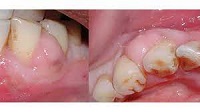Introduction
Front tooth cavity filling and chipped tooth filling are common dental procedures that can help restore the appearance and functionality of your teeth. Whether you’ve experienced dental trauma or have a cavity in one of your front teeth, understanding these procedures is essential for maintaining a healthy and confident smile. In this comprehensive guide, we will explore the ins and outs of front tooth cavity filling and chipped tooth filling, including the reasons behind these issues, the treatment process, and what to expect during and after the procedures.
Understanding Front Tooth Cavity Filling
What Causes Front Tooth Cavities?
Front tooth cavities, also known as dental caries, are typically caused by the accumulation of plaque and bacteria on the tooth’s surface. These harmful microorganisms feed on sugars and produce acids that gradually erode the tooth enamel, leading to cavities. In the case of front teeth, their prominent position makes them susceptible to these issues, as they are often the first to come into contact with food and beverages.
Symptoms of Front Tooth Cavities
Identifying a cavity in your front tooth is crucial for timely treatment. Some common symptoms of front tooth cavities include:
- Sensitivity to hot or cold temperatures.
- A visible hole or pit in the tooth’s surface.
- Discoloration or dark spots on the tooth.
- Pain or discomfort when biting or chewing.
The Importance of Prompt Treatment
Front tooth cavities can significantly impact your smile’s aesthetics and functionality. Delaying treatment can lead to more extensive damage, which may require more invasive procedures like root canals or extractions. Therefore, it’s essential to seek dental care as soon as you suspect a front tooth cavity.
Front Tooth Cavity Filling Procedure
Front tooth cavity filling is a relatively straightforward dental procedure that aims to restore the damaged tooth to its normal function and appearance. The process involves the following steps:
Anesthesia: To ensure your comfort during the procedure, your dentist will administer local anesthesia to numb the affected area, preventing any pain or discomfort.
Removal of Decay: The dentist will remove the decayed portion of the tooth using a dental drill or laser. This step is critical to prevent the cavity from spreading further.
Cleaning and Preparation: After removing the decay, the dentist will clean the area to eliminate any residual debris. The tooth is then prepared for the filling material.
Filling Material: Various filling materials can be used, including composite resin, amalgam, or porcelain. Composite resin is a popular choice for front teeth as it can be color-matched to your natural teeth, providing a discreet solution.
Shaping and Polishing: The dentist will shape the filling to match the natural contours of your tooth and polish it to ensure a smooth and aesthetically pleasing finish.
Final Check: Before completing the procedure, the dentist will check your bite to ensure that the filling does not interfere with your natural occlusion.
Aftercare and Recovery
After a front tooth cavity filling, it’s normal to experience some sensitivity or discomfort. This usually subsides within a few days. It’s essential to follow your dentist’s post-treatment instructions, which may include:
- Avoiding very hot or cold foods and drinks.
- Practicing good oral hygiene, including regular brushing and flossing.
- Scheduling follow-up appointments to monitor the filling’s condition.
Chipped Tooth Filling
Common Causes of Chipped Teeth
Chipped teeth can occur due to various reasons, including:
- Accidents or trauma, such as falls or sports injuries.
- Biting on hard objects or foods.
- Teeth weakened by cavities or previous dental work.
- Bruxism (teeth grinding) or clenching.
Symptoms of Chipped Teeth
A chipped tooth may present with different symptoms, depending on the extent of the damage. Some common signs include:
- Visible cracks or chips on the tooth’s surface.
- Pain or discomfort when biting or chewing.
- Sensitivity to hot or cold temperatures.
The Importance of Chipped Tooth Filling
Leaving a chipped tooth untreated can lead to several complications, such as:
- Increased risk of infection or decay.
- Further damage to the tooth.
- Affecting your smile’s aesthetics.
Chipped Tooth Filling Procedure
Chipped tooth filling aims to repair the damage and restore the tooth’s appearance and function. The procedure generally involves the following steps:
Anesthesia: Just like with front tooth cavity filling, local anesthesia is administered to numb the area around the chipped tooth.
Cleaning and Preparation: The dentist will clean the affected area and prepare the tooth for the filling.
Filling Material: The choice of filling material depends on the extent of the damage. Composite resin is commonly used for small to moderate chips, while more extensive damage may require porcelain or crown placement.
Shaping and Polishing: The dentist will shape the filling material to match the natural contours of the tooth and polish it for a seamless finish.
Final Check: The dentist will ensure that the filling does not interfere with your natural bite.
Aftercare and Recovery
Recovery from chipped tooth filling is typically straightforward. You may experience mild discomfort or sensitivity, which should subside within a few days. To ensure the longevity of the filling, it’s essential to:
- Avoid biting on hard objects or using your teeth for tasks other than chewing.
- Maintain good oral hygiene to prevent further damage.
- Attend follow-up appointments as recommended by your dentist.
Conclusion
Front tooth cavity filling and chipped tooth filling are vital dental procedures that can help restore the beauty and functionality of your smile. Timely treatment is essential to prevent complications and further damage. With advancements in dental technology, these procedures have become more comfortable and aesthetically pleasing than ever before. If you suspect a front tooth cavity or have a chipped tooth, don’t hesitate to consult with your dentist and explore the options available to you. A confident and healthy smile is just a dental visit away.


